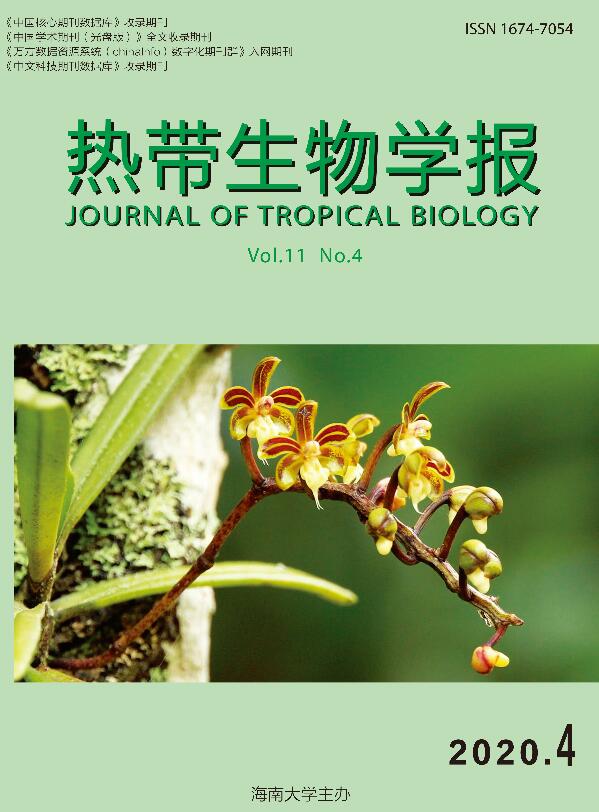-
天牛(Cerambycidae)隶属于昆虫纲(Insecta)鞘翅目(Coleoptera),为天牛总科一类昆虫的统称,是为害林木、园林绿化树木、果树以及花卉的重要蛀干害虫类群,它是一类较特殊的昆虫,天牛是一类较为特殊的昆虫,其幼虫生活隐蔽,种群发生发展较稳定,且天牛蛀孔复杂,成虫体壁和鞘翅坚硬且厚耐药性强,种类繁多、分布广泛、周期性爆发、危害严重、难防难治。全世界已知天牛约为4 000属35 000种以上,中国约有3 000多种,我国大部分区域均有分布,严重影响全球农林业及生态环境的健康持续发展[1-4]。在我国常见的天牛主要有光肩星天牛(Anoplophora glabripennis)、云斑天牛(Batocera horsfieldi)、桑天牛(Apriona germari)、青杨天牛(Saperda populnea)、桃红颈天牛(Aromia bungii)和双条杉天牛(Semanotus bifasciatus)等[5-7]。天牛以幼虫蛀食主干和根,轻者造成枯枝,易遭风折或被其他病原菌侵害;随着时间推移,重者可导致植物整株死亡;成虫以嫩枝皮层为食,致使枝梢枯萎[7]。天牛通常隐居于树内,幼虫或未羽化的成虫在树干内生活且躲避寒冷的冬天,其全部发育过程均在树皮下及木质部内进行,阻碍了树木的正常发育,也为该类群害虫的防治增加了难度。为害严重时能使植株败坏,同时导致植株遭受其他病原菌的侵害[8]。天牛还可作为其他病虫害的传播媒介,以松墨天牛(Monochamus alternatus)为例,可传播松材线虫,引起松林面积枯死,是我国重要的检疫害虫[9-10]。天牛危害日益严重,已严重制约了林业、果业的发展,为减少天牛的种群密度,降低天牛的危害性,国内外植保工作者积极寻求有效的防治措施[11-12]。鉴于天牛的发生特点,采用化学防治等传统方法对天牛进行防治,往往收效甚微[4]。近年来,天牛化学生态学种群层面上的防治技术已成为立体防治天牛极为重要的新途径[13-14]。天牛化学生态学研究包括种内和种间信息素两方面,前者主要是对性信息素的研究,后者主要探讨天牛成虫与寄主(营养与产卵)之间的信息关联[15]。笔者根据前人的研究成果,对天牛信息素的研究进行综述,并分析了天牛信息素的应用前景,旨在为天牛的综合防治提供参考。
-
天牛性信息素的研究始于40年前,迄今已报道了31种天牛的性信息素[16-17]。其中,有16种天牛的性信息素成分得到鉴定,主要集中在天牛亚科和沟胫天牛亚科。天牛雌雄成虫均可释放性信息素,但存在一定的差异[18-19]。葡萄虎天牛(Xylotrechus pyrrhoderus)雄虫释放的性信息素最先被分离鉴定出来,其组分为(2S,3S)−辛二酸和(2S)−羟−3−辛酮[20]。随着天牛雄虫释放性信息素的研究的逐渐深入,性信息素的成分和结构更加明确。现在研究的热点主要集中在光肩星天牛、咖啡灭字脊虎天牛(X. quadripes)和松墨天牛(Monochamus alternatus)[21]。Migdolus fryanus是第1个被报道的能够释放性信息素的天牛雌虫,经鉴定其释放的性信息素化学成分为N−(2S)−甲基丁酰基−2−甲基丁胺[22]。钱凯等利用气谱−质谱联用和气谱−傅立叶红外联用技术对柳杉纹虎天牛(Anaglyptus subfasciatus)雄虫性信息素的化学结构进行了分析,发现其化学成分主要由3−羟基−3−己酮和3−羟基−2−辛酮组成[23]。Hall D R等对大部分分布于中国和亚洲地区的咖啡灭字脊虎天牛的性信息素进行鉴定,结果发现,其主要化学成分为(S)−2−羟基−3−癸酮、3−羟基−2−癸酮和(S,S)−2,3−二羟基辛烷[24]。山谷接骨木天牛(Desmocerus californicus dimorphus)雌性能够释放一种特异性的化合物—(4R,9Z)−十六基−9−庚酰基−4−戊内酯,进一步的气相色谱−触角电图联用分析结果表明,该化合物能够引起雄性天牛触角的强烈反应[25]。
按照性信息素的作用范围,通常可将天牛性信息素分为长距离性信息素(long range sex pheromone)、短距离性信息素(short range sex pheromone)和接触性信息素(contact sex pheromone)[26]。天牛短距离性信息素大部分由雌虫释放,一般是具有甲基支链的表皮烃和酮类物质的化学结构,碳链较长,因此,挥发性低、有效作用距离短[27];长距离性信息素主要是由不补充营养、扩散能力弱甚至丧失飞行能力的天牛雄虫释放,通常由6~10个碳原子组成的α−羟基酮或(α,β)−二醇组成。同时,具有飞行能力的天牛成虫,他们同样能够产生长距离性信息素[26, 28];而接触性信息素则是通过雌雄成虫之间相互接触从而导致性识别的信息素,在天牛寻求交配时发挥重要作用,其通常存在于雌性体表,由第2或第3碳链上带有羟基或羰基的6碳、8碳或10碳组成[26, 29-30]。
天牛性信息素在种群繁衍过程中能显著影响成虫的求偶交配和产卵行为[30]。大量的研究表明,鞘翅、胸部和体壁是天牛性信息素的主要产生部位。而触角则是天牛感受性信息素的主要器官,并且性信息素发达的种类,其触角常常呈现出显著的性二型现象[31]。雄性天牛释放信息素的时候,通常采用“俯卧撑”姿势,以便使信息素更好的释放到空气中,从而达到吸引雌虫的目的[32]。天牛体表不同部位的提取物引起天牛的行为反应也有所不同,有些天牛用触角碰触雌性后利用触器接触雌性翅鞘和前背板,爬上雌性,紧接着雄性便会卷曲腹部,伸出生殖器到雌性腹部下,这种腹部卷曲持续到交配开始,这些天牛的交配行为都由雌虫体表的接触性信息素来启动[2, 33]。
-
天牛聚集信息素的研究起步较晚,新荣天牛属(Neoclytus)的N. acuminatus acuminatus产生的聚集信息素是关于天牛科产生聚集信息素的首次报道[34]。田间生物测定试验表明,雄性产生的聚集信息素能够吸引雌性二性,进一步的试验证实,该信息素的主要成分为(2S,3S)−己二醇,该化合物为雄性天牛所特有[34]。近年来,能够产生聚集信息素的天牛种类和数量不断增加,对此方面的认识也不断加深。
对截尾丽虎天牛(Plagionotus detritus ssp.)雄性产生的聚集信息素进行气相色谱−质谱分析,结果发现,截尾丽虎天牛除了能够释放少量的2,3−己二酮和2,3−辛二酮外,聚集信息素还含有大量的(R)−3−羟基−2−己酮和(S)−2−羟基−3−辛酮。这也给截尾丽虎天牛的种群检测提供了有价值的参考,同时可能在复杂的生态环境研究以及物种保护方面起到积极的作用[35]。对南美天牛(Susuacanga octoguttata)雄性产生的聚集信息素进行鉴定、合成以及室外生物测定试验后发现,该信息素的主要成分为(Z)−7−十六烯,并且这种物质对雌雄天牛均具有一定的吸引力[36]。更多的研究发现,雄性天牛产生聚集信息素吸引雌性二性的现象在其他天牛科中普遍存在。桃红颈天牛是一种严重危害樱桃、杏和桃子的害虫,鉴定发现其雄性合成的聚集信息素是一种新型的化合物,(E)−2−顺式−6,7−环氧壬烯。而在中国的田间试验中,该信息素能够吸引天牛的雌雄二性[37]。LACEY E S等对喜好取食新伐树木的厚垫黄带蜂天牛(Megacyllene caryae)进行生物测定,结果证实,雌雄二性天牛均能够被雄性天牛释放的聚集信息素所吸引;对雄性的气味进一步分析后发现,该信息素包含了(2R,3S)−2,3−己二醇等8种化合物[38]。此外,观察发现,大部分天牛释放的聚集信息素来源于雄性前胸腺的气孔,但一些没有前胸腺气孔的天牛也能产生聚集信息素[39]。
-
寄主信息素,又称他感物质,一般为植物的挥发性物质,多为复合成分,其组分和构成比例是其特异的基础[40]。寄主信息素既是同种生境模式下植物类群之间的特定信号物质,也是直接影响天牛成虫取食与产卵选择的重要信号物质,在天牛寻找特定寄主和配偶行为中起着十分重要的作用[41]。萜烯类和醇类物质是寄主信息素的常见成分。室内生测试验证实,(R)−(−)−芳樟醇、(3Z,6E)−α−法尼烯和(E)−β−法尼烯是吸引暗褐断眼天牛(Tetropium fuscum)雌雄二性的主要物质[40, 42]。江望锦等用正己烷对寄主樟子松进行提取后发现,α−蒎烯对家天牛(Hylotrupes bajulus)的引诱活性最强,而乙醇对家天牛几乎没有引诱活性,并且没有性别偏向性[40]。桃金娘烯醇对家天牛也有极大影响,高浓度下,家天牛表现出驱避性,低浓度下,变现为引诱性[40, 43]。类似的现象在紫薇星天牛(Anoplophora malasiaca)中同样存在。研究发现,紫薇星天牛的寄主温州蜜柑能够释放β−榄香烯等倍半萜烯烃类物质,而雌性天牛鞘翅中的物质和寄主植物释放的信息素基本一致[44],这也充分表明寄主信息素和紫薇星天牛引诱作用密切相关,寄主信息素在天牛搜寻配偶的过程中发挥着重要的作用。
-
天牛信息素是对害虫综合防控的有效手段,是“寄主植物−天牛−天敌”立体防治模型的有效补充,也是天牛监测和防治研究的热点之一[2]。天牛信息素防控天牛具有针对性强、不易产生抗性等优点,是未来进行有害生物综合防治的重点发展方向[45]。日本早在1980年就开展了松墨天牛引诱剂的研究,试验后发现,该引诱剂与φ=50%的乙醇混用可以大幅度提高林间天牛成虫的引诱效果[46];新西兰于2000年初建立探测新定居种的早期预警体系,应用α−蒎烯、乙醇以及小蠹二烯醇等制成的诱芯对梗天牛属天牛(Arhopalus ferus)进行诱捕,取得了理想的效果,为早期预测新入侵及定居的物种,提高消除害虫的成功率提供了重要的参考[47];钱明惠等以松墨天牛的聚集信息素壬醛N为主要配方来调查评价壬醛N对松褐天牛的林间引诱作用,结果表明,用松褐天牛雄虫产生的聚集素N对雌雄虫均有一定诱集作用,同时也发现,聚集素N与寄主信息素混用、聚集素N与小蠹聚集信息素混用诱集效果明显增强[6],该研究为聚集素N作为防治松墨天牛提供了新的思路。2−甲基−1−丁醇和3−羟基−2−己酮作为聚集信息素的2种主要成分,对栎红天牛(Pyrrhidium sanguineum)和黄褐棍腿天牛(Phymatodes testaceus)具有很强的引诱活性[48-49];(6E,8Z)−6,8−Pentadecadienal是由杧果天牛(Chlorida festiva)和Chlorida costata释放的一类具有新型结构的性信息素,而以这种化合物为诱饵能较好地捕获天牛成虫[49];有研究表明,不同类型信息素复合使用可有效提高天牛引诱效果,单纯的信息素与寄主信息素对天牛的引诱效果一般,当将性信息素(3−羟−2−己酮和3−羟−2−辛酮)以及寄主信息素(甲基苯甲酸酯)混合使用时,其引诱效果比两者单独的效果好[50]。朱宁等研究了聚集信息素和寄主信息素对光肩星天牛和星天牛(A. chinensis)的诱捕效果,结果表明,无论是单独使用聚集信息素或者寄主信息素,或二者联用,都能够表现出较高的诱捕效果。聚集信息素与苦楝混合配方(4−庚氧基丁醇+4−庚氧基丁醛+莰烯+顺−3−己烯−1−醇+罗勒烯+β−石竹烯)对光肩星天牛和星天牛的诱捕效果最好,前者诱捕到的两种天牛中雌虫所占的比例更高,后者诱捕到的雄虫比例更高[26, 51],这意味着不同的信息素对其性别的影响是有偏向性的,同时也意味着人们能利用这一特性阻止天牛交配进而阻断天牛种群发生规模的扩大。胡琴[52]的研究结果表明,寄主信息素能够在长距离下诱捕到松墨天牛,而聚集信息素只能在短距离下发挥作用,二者联合使用具有增效作用。由α−蒎烯和乙醇与聚集信息素2−十一烷氧基−1−乙醇复配研制出的引诱剂APF−I型,表现出显著的松墨天牛诱捕效果,并且能同时诱捕雄虫和雌虫,作为一种灵敏高效、环境友好、不易产生抗性的防治方法,可以有效防治松墨天牛[53]。
-
天牛具有生活史复杂、生活隐蔽、不易追踪、蛀孔复杂、耐药风险高以及繁殖能力强等特点,使得传统的物理防治、化学防治等手段效果不显著[30]。随着全球环境日渐恶化,世界各国对环境保护与治理的越来越重视,我国的生态文明建设也将环境保护放在了重要地位,因此,寻求更加安全高效、生态环保的防治策略和方法的诉求愈加强烈[54]。信息素在天牛觅偶、交配等行为中起着重要的作用,利用天牛信息素防治害虫,在害虫综合治理中已经展现出巨大的潜力,在过去的几年时间里取得了显著进展。当前针对信息素的研究主要集中在天牛的性引诱剂和植物性引诱剂的开发和应用方面,如将天牛信息素和植物性引诱剂配合使用、引诱活性测定和缓释技术以及诱饵树和引诱剂的配套使用等。这些相关技术的开发与研究能够更加高效地进行害虫监测和防控。但由于试验技术不完善、基础研究不深入、环境因素限制等原因,使得天牛信息素在害虫防治过程中存在一定的局限性,给实际应用带来了困难。通过不同信息素的搭配使用能够更有效的调控天牛行为,降低害虫种群密度,抑制害虫的危害。因此,在危害区,通过栽培引诱树种,结合植物性引诱剂及高效杀虫剂的应用技术,具有显著的诱杀效果,但也应该注重引诱树种的更新和复壮,确保引诱作用的持效性;同时,应该开发新型天牛综合防治技术,通过新型农药、天敌昆虫、信息素等多途径防控技术,以达到绿色、安全、精准的防控目标。
如今,得益于各种技术手段与交叉学科的发展,科学家们对各自领域的研究不断深入。在害虫防治方面,围绕“寄主植物−天牛−天敌”之间的三级营养关系为中心的立体防治方法与策略也有相关的报道出现[55]。今后将从这种关系上寻找物理防治,新型化学药剂防治,生物防治等,重点发展生物防治中有关信息素防治方法与策略。天牛信息素的研究为实现绿色环保、可持续、高效的防治天牛灾害开辟了一条崭新途径,可以预见,随着时间的推移,天牛的信息素研究将取得更多的进展与突破。
Research Advances in Semiochemicals of Cerambycid Beetles
doi: 10.15886/j.cnki.rdswxb.2020.04.015
- Received Date: 2020-05-26
- Rev Recd Date: 2020-07-20
- Available Online: 2021-01-27
- Publish Date: 2021-01-27
-
Key words:
- Cerambycid beetles /
- sex pheromones /
- aggregate pheromones /
- host pheromones /
- research progress
Abstract: Cerambycid beetles (Coleoptera: Cerambycidae) are an economically important group of insect pests which cause damages to forestry and fruit industry. They are numerous in species, widely distributed and hard to control due to their better protection mechanism and periodic outbreak, leading to serious infestation. Population control in the chemical ecology of cerambycid beetles has recently become a novel approach for integrated control of cerambycid beetles since the traditional insecticidal control of cerambycid beetles is less effective. Insect pheromones have the advantages of very low application rate, high efficiency, non-toxicity and no pollution, and can be used for target pest monitoring and trapping, which plays a key role in integrated pest control. The previous researches of cerambycid pheromones were reviewed, and an outlook for application of the cerambycid pheromones were made to provide reference for the integrated control of the cerambycid beetles.
| Citation: | HU Faguang, BI Xiaofei, FU Xingfei, LI Guiping, Li Yanan, LV Yulan, HUANG Jiaxiong. Research Advances in Semiochemicals of Cerambycid Beetles[J]. Journal of Tropical Biology, 2020, 11(4): 517-522. doi: 10.15886/j.cnki.rdswxb.2020.04.015 |






 DownLoad:
DownLoad: